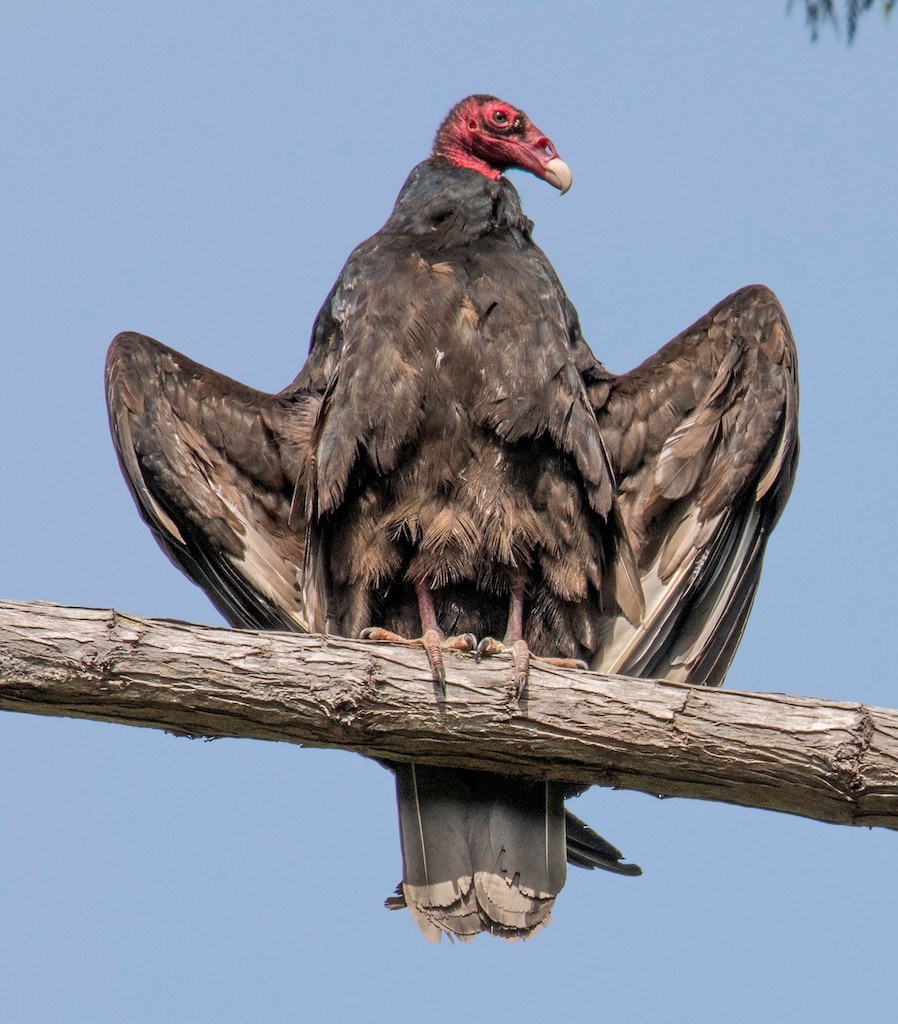Turkey vultures (Cathartes aura) are my favourite harbingers of spring on Bowen. They arrive in March and stay in our skies, cruising for carrion, feeding and breeding through the summer. The last ones remain until late October, when they migrate to their winter range in the Southwestern U.S. and Mexico, some reportedly even reaching Central and South America. Very rarely, overwintering vultures are observed on the south coast of B.C. Our second-largest bird after eagles, a turkey vulture’s wingspan can reach six feet (182 cm) and the perched body can stand up to 32 inches (81 cm) high.
In summer, turkey vultures (also referred to as TVs) can be seen throughout southern B.C. We usually see them soaring, either alone or in widely-spaced groups, occasionally with eagles, ravens or hawks, as they catch the thermals rising from the south-facing bluffs ands cliffs and spiral upward. TVs appear to use the spread feathers of their wingtips to delicately feel for the best updrafts. In flight, their wings are held in a shallow V, often rocking back and forth, very seldom flapping; this helps us humans tell them apart from the flat-winged profile and steadier flight of other similar-sized birds. Vultures typically return in the evening to favoured roosting trees inland or on the shoreline where they gather in groups, sometimes perching through the day during cold and wet weather. TVs can survive for up to two weeks between meals.
Turkey vultures nest almost exclusively in wilderness areas. In our region, their nests are usually simple groups of sticks or limbs laid on the ground in a cave or on a ledge in very steep terrain; in other parts of their range, they are known to also nest in hollow logs and even old barns. The mated pairs are monogamous. Up to two eggs are laid between mid-April and late June, are incubated by both parents, and take five to six weeks to hatch. The chicks are fluffy white with black faces. The fledglings leave the nest between mid-May and late August. The young of the year can be identified by their gray head compared to the red head of the adults. The population on Bowen over the past several years appears to peak at about eight to ten birds by the end of summer.
Turkey vultures do not hunt and kill their prey (except possibly snakes and amphibians); they are true scavengers. Their mainstay is any decaying animal flesh––preferably recently dead––ranging from the carcasses of deer, birds, squirrels and snakes, including roadkill, to fish, gulls, seals and other animals washed up on the shore. While other raptors depend mainly on “eagle-eyes” to find food, TVs also rely on their extraordinarily acute sense of smell to detect carrion, even under the forest canopy. For this reason, they are often seen flying low over the treetops. (In fact, by the time you can smell a dead animal on Bowen, it’s likely already been a TV’s dinner!) Other carrion eaters, such as the bald eagle, rely on turkey vultures to find new carcasses; when an eagle arrives, the TV stands aside while the larger eagle, with its sharper bill, cuts through the tough skin and tears into the flesh. Once the eagle has had its fill, the vulture moves back in to have its share.
These birds are sometimes incorrectly accused of carrying diseases that affect livestock and people. However, pathogenic viruses and bacteria are known to be destroyed in the vulture’s digestive tract. Their immune system is very sophisticated, which allows them to thrive even though repeatedly exposed to the germs associated with rotting flesh. The featherless head and upper neck, the habit to often perch with wings open to the baking effect of sunshine, and meticulous preening are thought to be other adaptations to prevent infection. In fact, turkey vultures are important members of nature’s cleanup crew. And, as with any carrion eater, they can be harmed when hit by vehicles or consuming animals killed by poison. They are legally protected under the federal Migratory Birds Convention Act and the provincial Wildlife Act.
A special thank-you to Bowen Islander John Bakes for permission to use his excellent photographs of this amazing native bird.
Since 1985, Bowen Nature Club members have been dedicated to the enjoyment, understanding and preservation Bowen Island’s diversity. For additional information, or to report any sightings of Turkey Vulture roosting trees, nests or young, please visit bowen-natureclub.blogspot.com/



